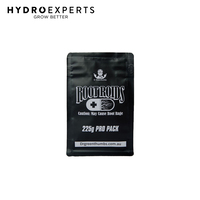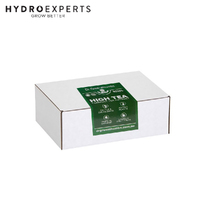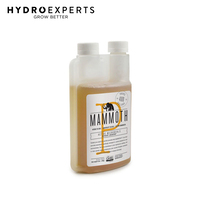Mycorrhizae are fungi that create a symbiotic relationship with your plants and can aid tremendously in a number of stages of life. This fungus gives new or recently transplanted plants a head start on life, and can help buffer stresses from the environment. This fungus goes by a few other names, such as beneficial bacteria and root occulants, and grows in the root zone of the plant. It forms a mutualistic relationship with the plant by establishing a network of fibres extending from the plant's original roots, and aiding in nutrient and water uptake, reaching areas and nutrients the plant originally was unable to.
There are many different types of beneficial bacteria indoor growers can use in the garden, the most common being soil-borne beneficial bacteria. There are many different strains of bacteria that live underground and provide benefits to plants. Some of the mycorrhizae we sell are from Great White and Xtreme Gardening. SHOP today for more products. Visit in-store or shop online. Only at HYDRO EXPERTS!
Q: How Do Mycorrhizal Fungi Increase Nutrient Uptake?
A: Mycorrhizal fungi play a vital role in enhancing nutrient uptake in plants through several mechanisms:
-
Increased Absorbing Area: Mycorrhizal fungi act as natural extensions of a plant's root system. They form a network of fine filaments (hyphae) that extend into the soil, greatly expanding the surface area for nutrient absorption. Unlike plant roots, mycorrhizal hyphae can absorb nutrients along their entire length.
-
Access to Inaccessible Areas: The diameter of mycorrhizal hyphae is much smaller than plant roots, allowing them to access soil regions that roots cannot reach. This enables the fungi to explore and extract nutrients from otherwise inaccessible areas.
-
Enzyme Secretion: Mycorrhizal fungi release enzymes into the soil that help break down and solubilize tightly bound soil nutrients. This enzymatic activity makes essential nutrients more available for plant uptake.
-
Reduced Nutrient Runoff: The improved nutrient-absorbing capacity of mycorrhizal associations reduces nutrient runoff from the soil, resulting in more efficient nutrient utilization by plants.
-
Enhanced Plant Performance: Mycorrhizal fungi contribute to better plant performance, especially in nutrient-poor or marginal soils. They assist in the uptake of applied fertilizers and nutrients, reducing the need for excessive fertilization.
-
Drought Resistance: Mycorrhizal plants are less susceptible to drought stress. The extensive fungal network helps plants access water from a larger soil volume, enhancing water uptake and storage.
Q: What Other Benefits Do Mycorrhizal Fungi Provide?
A: Mycorrhizal fungi offer a range of additional benefits to plants and soil ecosystems:
-
Improved Soil Structure: Mycorrhizal hyphae produce organic compounds that act as "glues," binding soil particles together. This improves soil structure and porosity, promoting aeration, water infiltration, root growth, and nutrient distribution.
-
Decreased Transplant Shock: Plants with established mycorrhizal networks experience reduced transplant shock and higher transplant success rates. Studies have shown that these plants are twice as likely to survive transplanting.
-
Enhanced Resilience: Mycorrhizal associations enhance a plant's resilience to environmental stressors, including disease, nutrient deficiencies, and extreme weather conditions.
Q: Do Mycorrhizae Control Plant Disease?
A: Mycorrhizal fungi do not possess pesticidal or disease-suppressing properties. Their primary role is to establish mutualistic relationships with plants to enhance nutrient and water uptake.
Q: Are Mycorrhizal Fungi Present in Compost?
A: Mycorrhizal fungi are not naturally present in compost because they are obligate symbionts that rely on a living plant host for survival. Additionally, the heat generated during the composting process can be detrimental to mycorrhizal propagules. Therefore, it is advisable to introduce mycorrhizae to soil or growing media after the composting process is complete.
Q: What If Too Much Mycorrhizae Is Applied?
A: There are no adverse effects associated with overdosing plants or soil with mycorrhizal inoculum. Similarly, applying the wrong type of mycorrhizae to a plant (e.g., ectomycorrhizae to an endomycorrhizal plant) will not harm the plant or the rhizosphere. In such cases, the mycorrhizae will remain dormant and have no negative impact.
Q: Can I Still Use Fungicides If I Apply Mycorrhizae?
A: Yes, mycorrhizae can be used alongside fungicides. However, it is advisable to wait for about 3-4 weeks after mycorrhizal inoculation before applying fungicides to allow for the establishment of the mycorrhizal relationship. Some fungicides may have unknown effects on mycorrhizae, so this precaution helps protect the mycorrhizal association. Alternatively, you can apply the fungicide before introducing mycorrhizae and wait a week before adding the mycorrhizal inoculum.
Q: Can Mycorrhizae Be Used with Other Biological Products?
A: Yes, mycorrhizae can be used in conjunction with other biological products, including beneficial bacteria (e.g., Actinovate) and Trichoderma (e.g., RootShield). Combining these biological agents can have synergistic effects and promote overall plant health and growth. Mycorrhizae typically do not interfere with the function of other beneficial microorganisms.
























